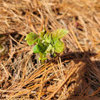Furstrating, Waterproof Soil in the Carolina Sandhills!
This is less a quest for help and information than an opportunity to rant in front of people who will understand.
I'm in the Carolina Sandhills. Several interglacials ago this was prime, beachfront property. The sandunes remain -- pure, white, quartz sand where nothing but pine trees grows with enthusiasm.
Since I'm nicely positioned on the side of a gentle slope I've got drainage that can cope with any amount of standing water. And yet, when you plant a garden you discover that this blasted stuff is waterproof.
Every time I plant a hill or a row I have to construct a little moat, trench, or dike to hold water around the planting area because if I just water it the way one would in normal soil (the way that worked in the pile of unsorted glacial till that was my soil in central Massachusetts a decade ago (never watered anything but new transplants in Western PA clay as a child)), the water dampens the surface then runs off.
Since I've reached the time of year that potatoes brought home from the store sprout in a week, I was doing spring cleaning on the potato bin. It occurred to me that the circle of fence I had used to hold plastic over a bed of winter lettuce would make an excellent potato barrel.
I have a number of piles of dirt left from last year when we stripped centipede grass off a new garden section and turned it over to kill the grass. So the decomposed grass should make the stuff at least marginally better than the norm.
I construct said barrel, attempt to water it, and the water runs right off the surface.
I spend 15 minutes using dead grass and soil to create a sort of adobe dam 8 inches tall around the outside rim of the thing so I can water by filling up the puddle 4-5 times.
Buying soil is not an option for me financially. Besides, we did buy $40 worth of it and, except for being mixed with a compost that is 20% coarse wood chips, its the same stuff with the same issues.
I know that I can transform this soil over the years through the addition of massive amounts of organic matter -- aka my neighbor's grass clippings (we use a mulching mower), and such leaves as I can find in an area where most trees are pine. But that will take time.
So I needed a place to express the extreme frustration of a gardener who is unable to get sand wet.







mamamia_farmer
iam3killerbsOriginal Author
Related Professionals
Ashland Landscape Architects & Landscape Designers · Prairie Ridge Landscape Architects & Landscape Designers · Springfield Landscape Contractors · Concord Landscape Contractors · Brookside Landscape Contractors · Aloha Landscape Contractors · Bridgeport Landscape Contractors · Cliffside Park Landscape Contractors · East Lake-Orient Park Landscape Contractors · Emmaus Landscape Contractors · Hampton Bays Landscape Contractors · Hilton Head Island Landscape Contractors · Huntley Landscape Contractors · Bensenville Landscape Contractors · Eustis Driveway Installation & Maintenancegardenlen
iam3killerbsOriginal Author
idaho_gardener
iam3killerbsOriginal Author